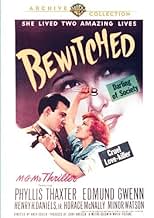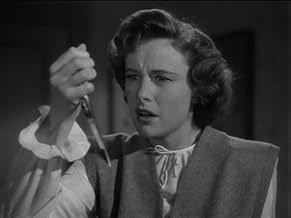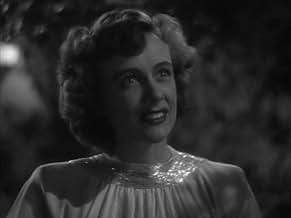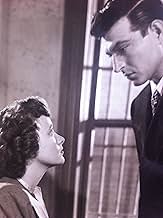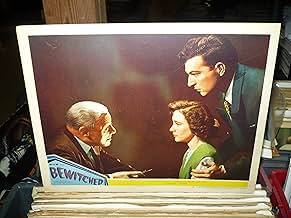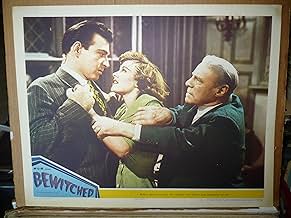A young woman has two distinct personalities, one of whom is evil and constantly gets her in trouble.A young woman has two distinct personalities, one of whom is evil and constantly gets her in trouble.A young woman has two distinct personalities, one of whom is evil and constantly gets her in trouble.
Stephen McNally
- Eric Russell
- (as Horace McNally)
Tom Coleman
- Juror
- (uncredited)
Clancy Cooper
- Cop
- (uncredited)
Eddie Dunn
- Prison Janitor
- (uncredited)
George Meader
- Juror
- (uncredited)
Howard M. Mitchell
- Juror
- (uncredited)
Featured reviews
Bewitched is written and directed by Arch Oboler. It stars Phyllis Thaxter, Edmund Gwenn, Henry H. Daniels, Addison Richards, Horace McNally and Kathleen Lockhart. Music is by Bronislau Kaper and cinematography by Charles Salerno Jr.
One of the most interesting of splinters to come out of film noir was that which dealt with psychoanalysis. Be it mentally scarred war veterans, amnesia sufferers with locked in repression, or a victim being pushed to the mental abyss by an outside force, the state of mind factor was ripe for any sort of film noir sheen.
What was under represented were films that dealt with mental illness' like schizophrenia or multiple (split) personalities. History tells us that Hollywood took a long time to get to grips with such topics, very much resorting to guesswork (and sometimes laughable) solutions to mental health issues just to close out the movies with a happy outcome.
It would take until 1957 and Three Faces of Eve (and to a lesser extent Hugo Haas' Lizzie released the same year) for the personality disorder issue to break out of Hollywood and into the public conscious. But even then with "Eve", if you take out Joanne Woodward's spell binding performance you are left with some mumbo-jumbo and a daft resolution to the curing of the patient.
So where does this leave Bewitched in 1945? Transferred from radio to the big screen by Oboler, from his own story titled Alter Ego, Bewitched suffers from the same simplified problems of so many like minded sub-genre movies, in that the resolution ("cure") is just so hard to get on board with. However...
If allowing the film some grace for the time it was made, then there's a very good picture here. Clocking in at just over an hour, it certainly feels and plays like one of those extended episodes of The Twilight Zone from Season 4, but the atmospherics and lead performances of cast members ensure this is fascinating and suspenseful entertainment.
Plot essentially sees Thaxter as troubled Joan Alris Ellis, who after starting to hear a sinister voice in her head (voiced by noir darling Audrey Totter), flees to New York to start afresh, leaving behind family and her intended husband to be. After becoming involved in a warm relationship with Eric Russell (McNally), Joan finds that the voice, her alter ego, is not going to go away and urges Joan to commit murder.
Pic unfolds in a flashback structure, Joan is awaiting execution and we learn how she came to be in this situation. Oboler and Salerno film the piece through a film noir prism, ensuring that a disquiet mood is prevalent throughout. As the lens' mist up and shadows fall (99% of film is set in darkness or daylight as darkness), the visuals marry up nicely with poor Joan's befuddlement.
Oboler is guilty of letting the piece meander at times, as it often becomes over talky (the radio origins practically scream from the speakers!), but he has a very sharp eye for an evocative scene, and he's also capable of telling tech flourishes. Joan running down a street lit by bulbous lamps is straight out of noirville, distorted angles come and go, and clocks feature prominently, like Old Nick is right there counting down the seconds on every clock face.
Then it's that resolution. Simplified for sure, but not without eeriness personified as Joan's femme fatale alter ego arrives on the scene in a clear case of angel and demon perched on either side of the hapless patient. With Thaxter excelling with her haunted portrayal, Gwenn exuding assurance unbound, and Kaper (Gaslight) drifting a creeping menace like musical score over the proceedings, the impact garnered belies the "B" budget afforded the play. 7.5/10
One of the most interesting of splinters to come out of film noir was that which dealt with psychoanalysis. Be it mentally scarred war veterans, amnesia sufferers with locked in repression, or a victim being pushed to the mental abyss by an outside force, the state of mind factor was ripe for any sort of film noir sheen.
What was under represented were films that dealt with mental illness' like schizophrenia or multiple (split) personalities. History tells us that Hollywood took a long time to get to grips with such topics, very much resorting to guesswork (and sometimes laughable) solutions to mental health issues just to close out the movies with a happy outcome.
It would take until 1957 and Three Faces of Eve (and to a lesser extent Hugo Haas' Lizzie released the same year) for the personality disorder issue to break out of Hollywood and into the public conscious. But even then with "Eve", if you take out Joanne Woodward's spell binding performance you are left with some mumbo-jumbo and a daft resolution to the curing of the patient.
So where does this leave Bewitched in 1945? Transferred from radio to the big screen by Oboler, from his own story titled Alter Ego, Bewitched suffers from the same simplified problems of so many like minded sub-genre movies, in that the resolution ("cure") is just so hard to get on board with. However...
If allowing the film some grace for the time it was made, then there's a very good picture here. Clocking in at just over an hour, it certainly feels and plays like one of those extended episodes of The Twilight Zone from Season 4, but the atmospherics and lead performances of cast members ensure this is fascinating and suspenseful entertainment.
Plot essentially sees Thaxter as troubled Joan Alris Ellis, who after starting to hear a sinister voice in her head (voiced by noir darling Audrey Totter), flees to New York to start afresh, leaving behind family and her intended husband to be. After becoming involved in a warm relationship with Eric Russell (McNally), Joan finds that the voice, her alter ego, is not going to go away and urges Joan to commit murder.
Pic unfolds in a flashback structure, Joan is awaiting execution and we learn how she came to be in this situation. Oboler and Salerno film the piece through a film noir prism, ensuring that a disquiet mood is prevalent throughout. As the lens' mist up and shadows fall (99% of film is set in darkness or daylight as darkness), the visuals marry up nicely with poor Joan's befuddlement.
Oboler is guilty of letting the piece meander at times, as it often becomes over talky (the radio origins practically scream from the speakers!), but he has a very sharp eye for an evocative scene, and he's also capable of telling tech flourishes. Joan running down a street lit by bulbous lamps is straight out of noirville, distorted angles come and go, and clocks feature prominently, like Old Nick is right there counting down the seconds on every clock face.
Then it's that resolution. Simplified for sure, but not without eeriness personified as Joan's femme fatale alter ego arrives on the scene in a clear case of angel and demon perched on either side of the hapless patient. With Thaxter excelling with her haunted portrayal, Gwenn exuding assurance unbound, and Kaper (Gaslight) drifting a creeping menace like musical score over the proceedings, the impact garnered belies the "B" budget afforded the play. 7.5/10
Or, if you prefer, Mrs. Jekyll & Hyde without the serum. Many offbeat, inventive touches in this eerie, unusual (for its time) paranormal thriller (including what must be the only close-up of new paper being inserted into a typewriter I've ever seen in a movie) ; not entirely successful (for one thing, we don't see enough of the "wild" Karen), but a most worthy effort. **1/2 out of 4.
I'm giving this a seven, because it's cinematically well crafted. I was very interested to see how it would end, given that the Production Code ensured that virtue would be rewarded-- so would the Code let anyone get away with murder?
The film's theme of split personality suffers from a profound ignorance of that disorder's mechanics, and confuses it with certain forms of schizophrenia, an error still common today. Schizophrenia is a psychosis, a mental illness treatable with medication, while Multiple Personality Disorder, now known as Dissociative Identity Disorder, is an acquired condition usually formed as a survival mechanism after unbearable trauma. In Bewitched it manifests more like demonic possession.
Dissociative Identity was first identified in the 1880s, but was still largely a mystery to many people. The idea of split personality readily leant itself to dramatic portrayal, especially onscreen, and this served to familiarize more of the general public with the condition. There was Blanche Sweet in "The Case of Becky" (1915) from the stage success by that name, remade in 1918 as "The Two-Soul Woman" with Priscilla Dean. Still to come were Constance Binney in a remake of "The Case of Becky" in 1921, followed by Gladys Walton in "The Untameable" (1923). Barbara La Marr took on a new treatment of the theme in "Sandra" (1924). More familiar today would of course be 1957's "The Three Faces of Eve" and later titles.
I couldn't help wondering why the poor girl never mentioned hearing that nasty voice in her head. Of course she didn't want people thinking she was CRAZY, so she just went on acting really disturbed, which had to suggest that she was-- well, DISTURBED.
The story makes no sense in psychological terms, so it's best not to worry about its half-baked medical aspects. Just figure that this nice girl somehow picked up a demon who wanted to take over. The demon 'Karen' is a vicious maneating floosy, itching to be set loose upon the world, and giving her Audrey Totter's voice makes her truly scary. If Karen ever got more than a few moments in control, woe to us all!
The film's theme of split personality suffers from a profound ignorance of that disorder's mechanics, and confuses it with certain forms of schizophrenia, an error still common today. Schizophrenia is a psychosis, a mental illness treatable with medication, while Multiple Personality Disorder, now known as Dissociative Identity Disorder, is an acquired condition usually formed as a survival mechanism after unbearable trauma. In Bewitched it manifests more like demonic possession.
Dissociative Identity was first identified in the 1880s, but was still largely a mystery to many people. The idea of split personality readily leant itself to dramatic portrayal, especially onscreen, and this served to familiarize more of the general public with the condition. There was Blanche Sweet in "The Case of Becky" (1915) from the stage success by that name, remade in 1918 as "The Two-Soul Woman" with Priscilla Dean. Still to come were Constance Binney in a remake of "The Case of Becky" in 1921, followed by Gladys Walton in "The Untameable" (1923). Barbara La Marr took on a new treatment of the theme in "Sandra" (1924). More familiar today would of course be 1957's "The Three Faces of Eve" and later titles.
I couldn't help wondering why the poor girl never mentioned hearing that nasty voice in her head. Of course she didn't want people thinking she was CRAZY, so she just went on acting really disturbed, which had to suggest that she was-- well, DISTURBED.
The story makes no sense in psychological terms, so it's best not to worry about its half-baked medical aspects. Just figure that this nice girl somehow picked up a demon who wanted to take over. The demon 'Karen' is a vicious maneating floosy, itching to be set loose upon the world, and giving her Audrey Totter's voice makes her truly scary. If Karen ever got more than a few moments in control, woe to us all!
Wholesome gal Phyllis Thaxter lives with her upper-middle-class parents and plans to wed soon. But she's beginning to cause some concern; she's prone to odd fainting spells blackouts, really and to wandering the deserted streets of her midwestern city at night. Scant wonder, because living inside her, and clawing to get out, is Audrey Totter! Totter, in fact, gives perhaps the most chilling voice-of-the-demon performance until Mercedes McCambridge gave us Pazuzu in The Exorcist.
Capitalizing on the heightened interest in abnormal psychology spurred by the return of shell-shocked veterans, Bewitched latches onto a tabloid-worthy subject multiple personality disorder. It's noteworthy in doing so a dozen years before both Lizzie and The Three Faces of Eve, in which, respectively, Eleanor Parker and Joanne Woodward (who nabbed the Oscar) displayed similar symptoms. Footnotes in medical journals probably do not cite any of these movies, so facile is their treatment of a troubling and controversial syndrome.
Thaxter tries a geographical cure, fleeing to New York where she falls in love with a lawyer (Stephen McNally). But when her old fiancé tracks her down, Totter, who apparently wasn't left behind, emerges to kill him with a pair of scissors. Then comes a stylized courtroom fantasy lifted all but intact from Boris Ingster's Stranger On The Third Floor, followed by a real murder trial. Wise old psychiatrist Edmund Gwynne explains everything to us, along with the Governor and his wife, and then proceeds to exorcize Totter (who, by the way, calls herself Karen).
Apart from Thaxter's nocturnal excursion, there's little original or striking about the movie. That we see the good girl but only hear the bad one is a big part of the problem. The extra energy that might have come from seeing Karen in action for that matter, from casting Totter on-screen gets thrown away. They picked the wrong personality.
Capitalizing on the heightened interest in abnormal psychology spurred by the return of shell-shocked veterans, Bewitched latches onto a tabloid-worthy subject multiple personality disorder. It's noteworthy in doing so a dozen years before both Lizzie and The Three Faces of Eve, in which, respectively, Eleanor Parker and Joanne Woodward (who nabbed the Oscar) displayed similar symptoms. Footnotes in medical journals probably do not cite any of these movies, so facile is their treatment of a troubling and controversial syndrome.
Thaxter tries a geographical cure, fleeing to New York where she falls in love with a lawyer (Stephen McNally). But when her old fiancé tracks her down, Totter, who apparently wasn't left behind, emerges to kill him with a pair of scissors. Then comes a stylized courtroom fantasy lifted all but intact from Boris Ingster's Stranger On The Third Floor, followed by a real murder trial. Wise old psychiatrist Edmund Gwynne explains everything to us, along with the Governor and his wife, and then proceeds to exorcize Totter (who, by the way, calls herself Karen).
Apart from Thaxter's nocturnal excursion, there's little original or striking about the movie. That we see the good girl but only hear the bad one is a big part of the problem. The extra energy that might have come from seeing Karen in action for that matter, from casting Totter on-screen gets thrown away. They picked the wrong personality.
Prototype Film-Noir from Stylist Arch Oboler who made His Name on the Radio with His Ultra-Popular "Lights Out" Program. Here He Adopts His Own Story "Alter-Ego" and brings it to the Screen for MGM.
This is One of the Few MGM Noirs of the First Wave. It would Take Years before the Haughty Studio would lend its Name Seriously to a Style so Dark.
Phyllis Thaxter gives a Good Performance in a Soul-Baring Role. Steve McNally is Miscast but manages to look Desperate and Edmund Gwenn as the Psychiatrist trying to Exorcise Thaxter's other Personality, the Evil One, is a Good Try.
With its Roots in Dr. Jekyll and Mr. Hyde, the only Reference Point at this Point for Multiple Personalities On Screen, Oboler delivers and Ultra-Stylish Descent into Schizophrenia.
The Film is Guilty of way too Much Verbiage, a Radio Drama influence, but it Balances it with Film Flourishes that are Atmospheric and Stunning.
The Movie Grips the Audience as it tries to Explain and Expose Psychiatric Methods and Procedures. But the Truth is that Not Much was Known at the Time and the Little that was Known was constantly Up for Debate in the Medical Community.
So it was No Easy Task Transferring this to the Movies. For Years Hollywood gave it a go with Extremely Inconsistent Results. It Was a Staple in Film-Noir and the Horror of Val Lewton but Main Stream and "A" Pictures were Reluctant to take it on for quite Some Time.
Overall, this is a Great Early Effort and a Striking Example of Film-Noir and the Psychological Pictures that Started a Run After the War and Never Stopped, and actually becoming a Genre of its own (The Psychological Thriller).
This is One of the Few MGM Noirs of the First Wave. It would Take Years before the Haughty Studio would lend its Name Seriously to a Style so Dark.
Phyllis Thaxter gives a Good Performance in a Soul-Baring Role. Steve McNally is Miscast but manages to look Desperate and Edmund Gwenn as the Psychiatrist trying to Exorcise Thaxter's other Personality, the Evil One, is a Good Try.
With its Roots in Dr. Jekyll and Mr. Hyde, the only Reference Point at this Point for Multiple Personalities On Screen, Oboler delivers and Ultra-Stylish Descent into Schizophrenia.
The Film is Guilty of way too Much Verbiage, a Radio Drama influence, but it Balances it with Film Flourishes that are Atmospheric and Stunning.
The Movie Grips the Audience as it tries to Explain and Expose Psychiatric Methods and Procedures. But the Truth is that Not Much was Known at the Time and the Little that was Known was constantly Up for Debate in the Medical Community.
So it was No Easy Task Transferring this to the Movies. For Years Hollywood gave it a go with Extremely Inconsistent Results. It Was a Staple in Film-Noir and the Horror of Val Lewton but Main Stream and "A" Pictures were Reluctant to take it on for quite Some Time.
Overall, this is a Great Early Effort and a Striking Example of Film-Noir and the Psychological Pictures that Started a Run After the War and Never Stopped, and actually becoming a Genre of its own (The Psychological Thriller).
Did you know
- TriviaAudrey Totter dubbed Thaxter's evil personality's voice.
- Quotes
Joan Alris Ellis: Bob, do you hear... someone talking?
- ConnectionsFeatured in The Late, Late Show: Bewitched (1962)
Details
- Runtime
- 1h 5m(65 min)
- Color
- Aspect ratio
- 1.37 : 1
Contribute to this page
Suggest an edit or add missing content


